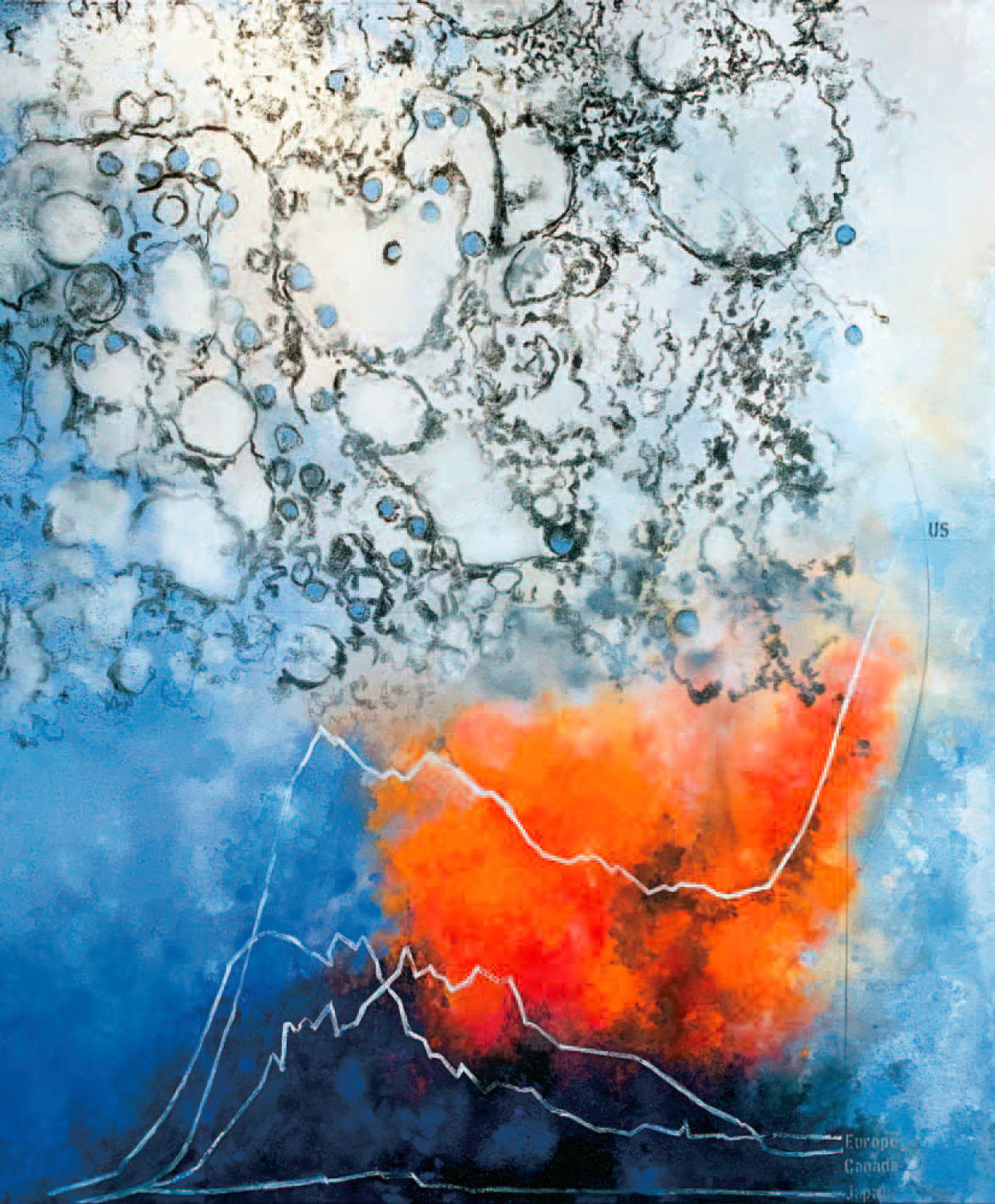Cellscape Vistas
By Michael Bennett
Assistant Director for Innovation Policy, School for the Future of Innovation in Society, Arizona State University
Jeffrey Kent has created the most vital, timely, commensurate artwork to engage the saga of Henrietta Lacks. Acknowledging that the action of the saga occurs in the realm of cells, rather than in the world of humans, its visual politics is scale-appropriate. And Kent transports us to this realm of action by way of his painterly technique, laying down varying thicknesses and stark color intervals. Revealed as topographies, the works exhort us to traverse them, not simply to view them. And Kent’s technical dynamism, nodding to action painters like Helen Frankenthaler, Jay DeFeo, Elaine and Willem de Kooning, and Jackson Pollock, captures the gross fecundity of the HeLa cell line.
“Feracious” may be the best adjective for HeLa. The line is notorious for its aggressive generativity. Ms. Lacks’s carcinoma-derived cells have germinated thorny questions spanning domains that seem also to bloom and propagate: Jim Crow-era racial politics, bioethics, Baltimore lore, the Oprah-verse, and Black American women’s often central, silent, subjugated place in medical research. And like the cell line that is its subject matter, Kent’s HeLa series is vigorously, almost playfully fecund.
It’s virtually impossible to think about HeLa for more than three seconds without monstrous techno-horrific figures coming to mind. There is the technical immortality of the cell line, its ability to continue replicating given adequate environmental conditions. Add to that its penchant for colonizing lesser cellular strains—even in hypersterilized lab environments designed specifically to prevent contaminations—and its history begins to sound like the replicator-based nightmares that American filmmakers have been conjuring up for the better part of a century. That this vigorous cell line began in Ms. Lacks’s cervical carcinoma, the condition that ultimately led to her bloody demise, exhibits particular affinities with the notably influential transmedia Alien franchise. Octavia Butler, scholars tell us, made explicit use of the HeLa saga in her Xenogenesis trilogy. There an extraterrestrial life-form finds great value in an African American female protagonist’s singular “talent” for creating cancerous cells, and it uses that talent to restart life on Earth after it has been devastated by an apocalyptic thermonuclear exchange.
The key virtue of Kent’s HeLa series is that it refuses to let us forget any of these lines of flight by expressing the cells’ dynamism at the level of technique.
The impasto technique that Kent reverently acknowledges having learned from Sam Gilliam imbues the series with a third dimension of variable depths. “If you master an impasto technique, people will want to eat your paintings up,” the master
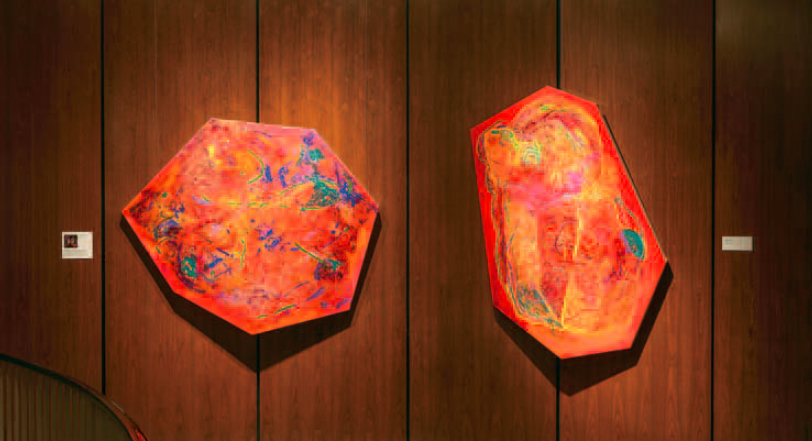
Artist Jeffrey Kent’s exhibition, Surface from Under the Microscope: The Henrietta Lacks Series, was on display at the National Academy of Sciences’ Upstairs Gallery from September 30, 2019, through March 13, 2020.
is said to have told the student. In combination with the fluorescent pallet Kent frequently deploys, the effect is not unlike an Olympic view down onto a complex, jungly terrain. Gilliam’s seductive endorsement works in reverse, too: for their juxtapositions of suggestive peril and invitations to explore, the paintings also threaten to consume, or at least envelop, viewers.
The HeLa series breaks so sharply away from the sentimental, human-centric representations of Ms. Lacks, as presented in Oprah’s HBO biopic The Immortal Life of Henrietta Lacks, and in the HBO-commissioned portrait of the movie’s protagonist, that it makes more sense to think of Kent’s works as something other, and arguably more, than portraits. Merging elements of expressionist portraiture and topographic cartography, the HeLa series is comprised of what we might call “cellscapes.”
The cellscape is superior to the photorealistic portrait in at least two ways. It more accurately and acutely witnesses the ongoing activity of its subject matter. The HeLa cells are, at the moment of your reading, enabling thousands of biomedical experiments, underwriting tens of thousands of biomedical treatments, and overrunning and colonizing other cell lines in who knows how many labs around the world. And in the public consciousness, HeLa has continuously inflamed debates across an extensive range of technical, experimental, and lay-popular domains. The cellscapes convey this dynamism and vigor. The photorealistic and televisual depictions of Ms. Lacks, particularly Kadir Nelson’s 2017 neo-Rockwellian portrait, Henrietta Lacks: The Mother
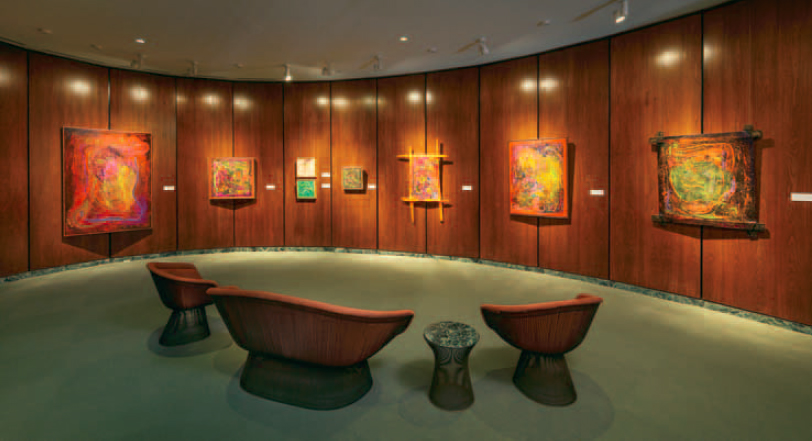
of Modern Medicine, are comparatively stagnant, born in a state of suspended animation, and suited to an officially concluded past. Now in the collection of the Smithsonian’s National Portrait Gallery, Nelson’s painting aims for its subject’s canonization, for her installation in the American civil rights iconographic pantheon. Nelson’s Ms. Lacks is literally nimbed. This Black woman’s cheeks are rosy. She shields her pelvis with the Bible. Stabilization and partial sanitization of the swirling complexities of her story are possibly encrypted somewhere in its luminescent, quasicreamy surface, but, if so, enclosed and entombed, as if the story, too, were permanently stabilized.
Secondly, the HeLa cellscapes function as a vista onto a three-dimensional mythos, a narrative terrain, perilous and likely unavoidable. Like all maps, whether empirical or imaginary, the cellscapes are invitational and suggestive of traversability. They bear witness to a way. Many have effectively argued that a capacity to witness, a classical function of Western painting, has dissolved under contemporary art markets’ pressures and ultra-acidic, post-Baudrillardian cynicism. The cellscapes look both backwards to an earlier, more earnest phase of art politics (“No, painting is not made to decorate apartments. It’s an offensive and defensive weapon against the enemy,” Picasso declared) and forward to probabilistic futures in which we are all Henrietta Lacks, our bodies, down to the molecules, standing reserves for bio-pirates at work just beyond the rim of accepted experimental norms and professional codes of conduct, hypnotically chanting their absolving mantra: What’s the problem?
Molecular Landscape: SARS-CoV-2 and Neutralizing Antibodies, 2020
Watercolor
13 x 10 inches
In this watercolor painting, a cross-section of the SARS-CoV-2 virus that causes the COVID-19 disease is surrounded by blood plasma, with neutralizing antibodies depicted in bright yellow. Commissioned by the journal Nature for the cover of its August 2020 COVID-19 special issue, it shows the virus, which is invisible to the naked eye, as a physical entity. In early 2020, molecular biologist and artist David Goodsell began creating portraits of the coronavirus in which he attempted to capture the rapidly evolving state of knowledge of the virus’ structure. This painting incorporates information from two cryogenic electron microscopy studies exploring the molecular architecture of the virus.
Goodsell’s research focuses on the structural biology of HIV as well as the structure and function of bacterial cells. He is known for his watercolor paintings of cell interiors, which integrate information from structural biology, microscopy, and biophysics. He started using watercolors as a tool to explore the workings of cells when he was creating early molecular graphics programs to visualize protein and DNA structures. He is a professor of computational biology at The Scripps Research Institute, San Diego, California, and a research professor at Rutgers University, New Brunswick, New Jersey, where he is the Scientific Outreach Lead at the Research Collaboratory for Structural Bioinformatics Protein Data Bank.
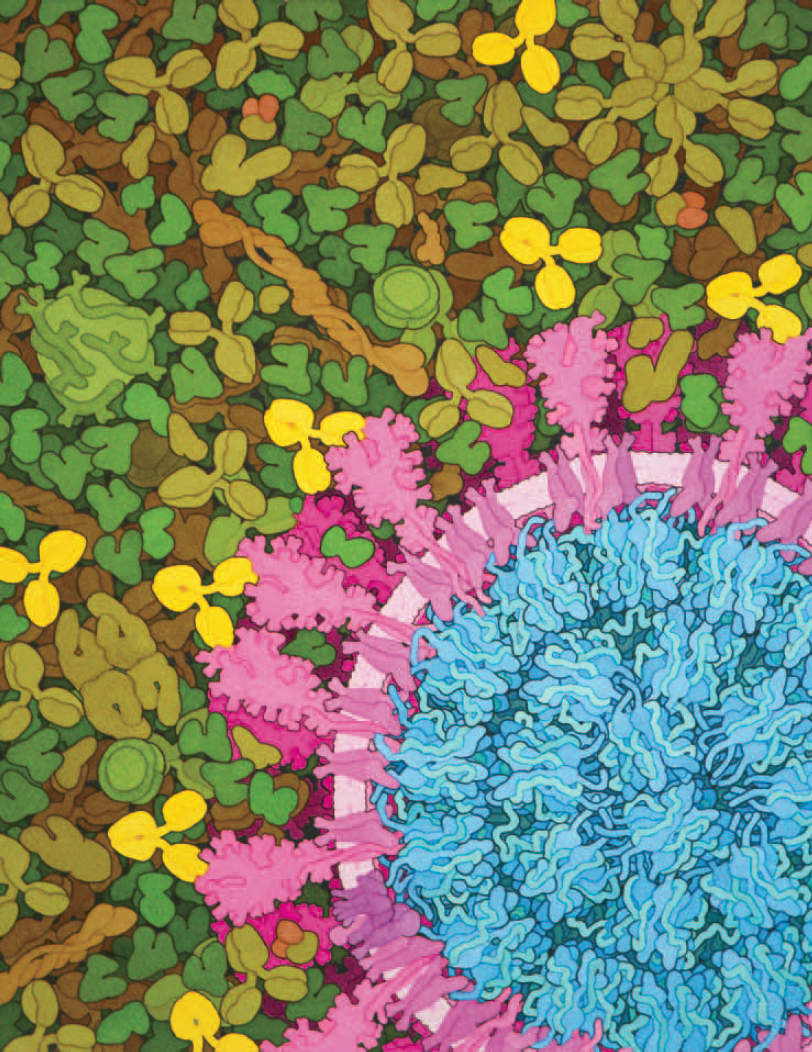
This page intentionally left blank.
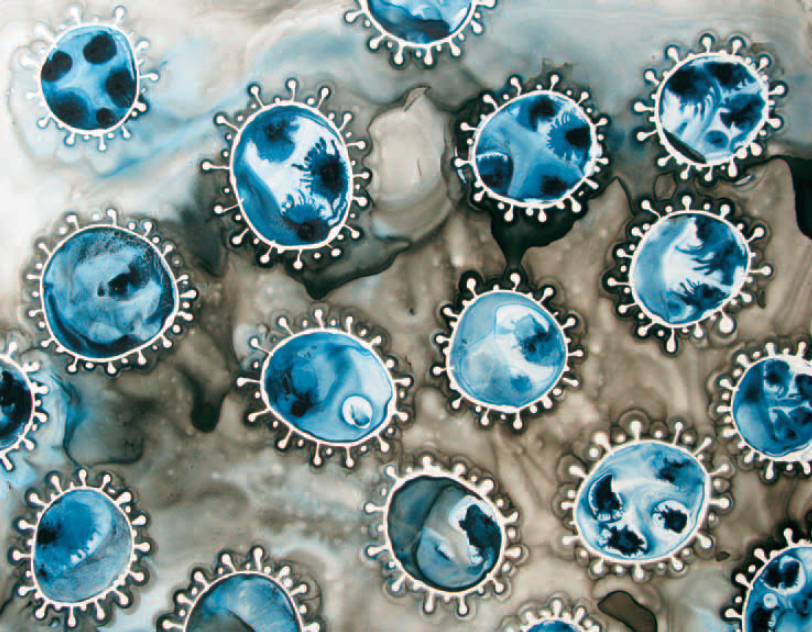
Indigo Coronavirus, 2020
Ink on Yupo paper
12 x 16 inches
Michele Banks is a Washington, D.C.-based artist who finds inspiration in how viruses and bacteria affect humans, and how in turn humans affect them, through climate change, antibiotic use, and other impacts on the Earth. For more than a decade, she has explored the idea that a world exists around us that we cannot see, a concept particularly evident during the COVID-19 pandemic. When the pandemic hit the United States, Banks began creating dozens of ink paintings inspired by the SARS-CoV-2 pathogen. She has shifted away from bright colors to a more limited palette of reds, blacks, and blues, reflecting the darkness of the times. But blue, according to the artist, represents a glimmer of hope for the development of a widely available, effective vaccine.

July 2020
Mixed media on canvas, 2020
60 x 60 inches
Gift of Ivy Silver and Steven Leshner
Painter, photographer, and videographer Diane Burko has been working at the intersection of art, science, and the environment for nearly 50 years. In 2020, inspired by the COVID-19 pandemic, she embarked on a new body of work. Here, she references global maps of the virus’ spread, graphs charting the curve of cases in the United States and overseas, and abstract visualizations of the microscopic SARS-CoV-2 virus. Burko writes, “In spite of this nightmarish time of the virus, I continue to make art in my studio…. That space is a respite from reality while also providing the opportunity to confront the pandemic with raw emotion, which is woven into the aesthetic fabric of my work.”
Born in Brooklyn and based in Philadelphia, Burko has focused her work over the past two decades on rapid changes in coral reef systems and the polar regions. She often performs her own on-site investigations and synthesizes that with data gathered from research and meetings with scientists. Her COVID-19 paintings are a natural evolution of these previous bodies of work, incorporating similar mapping techniques, colors, shapes, and textures. Whether facing the shifting environment or the pandemic, Burko urges us to transcend borders and differences to address global issues collectively.
